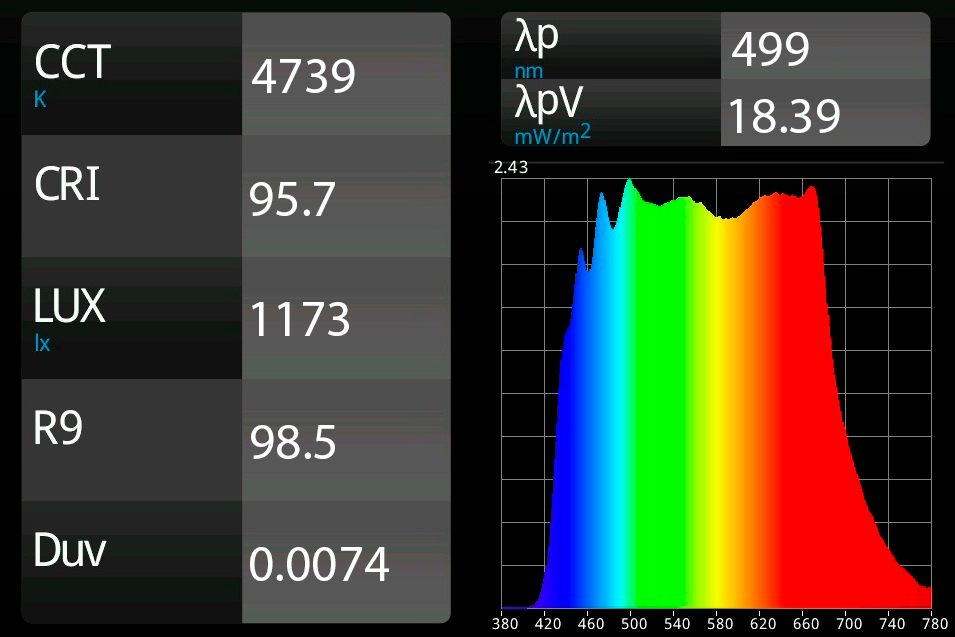Light for life
Light and its relationship to our lives, health, mood and performance
Visible light is a small part of the wide region of electromagnetic radiation that is otherwise invisible to the human eye. This electromagnetic spectrum of radiation represents photon particles that oscillate at a certain frequency, that indicates their wavelength. Photons with wavelengths in the range of 380 to 750 nm are visible to humans and thus constitute the visible spectrum. Their wavelength also determines the color of the light we can see, e.g., blue light has shorter wavelengths while red light has longer wavelengths. The combination of all colours hitting the retinas of our eyes (i.e. of photons of all visible wavelengths) gives rise to what we perceive as white light. and, by extension, white objects and surfaces it reflects off. If only some wavelengths (colours) are incident on our retinas, we perceive the light, or the object from which it is reflected, as coloured.
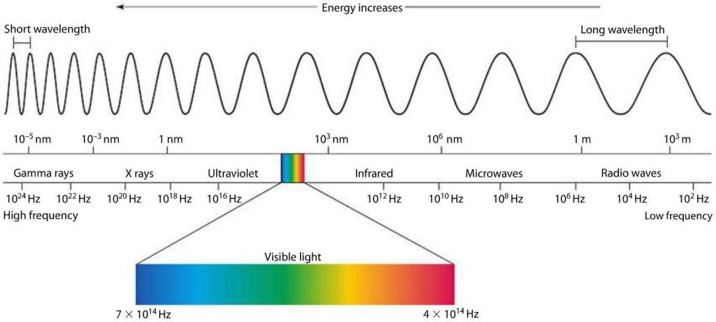
In addition to visual imaging effects, the light incident on our retinas has important non-image-forming (NIF, also known as non-visual) effects. These do not contribute to vision, but rather profoundly influence, entrain (or conversely desynchronise) the human circadian system (internal clock), sleep and hormone secretion.
Light sources, our eyes and the brain
The first eye appeared 541 million years ago in the primitive form of a light versus dark detector. Temporal anchoring through the perception of this light-dark cycle was more important than the visual image-forming functions that would evolve later.
For millions of years, sunlight, the spectrum of which contains all wavelengths and colours, has always shone on us during the day. The difference always occurred with the sunset, when shorter wavelengths, in particular blue, cyan and green, were filtered out in the atmosphere due to a change in their incident angle – a consequence of Earth’s rotation. As a result, during sunset only longer wavelengths could hit the eyes of all living things. This is the reason why sunset appears orange-red.
A natural and logical consequence of this phenomenon is that our internal clock (the circadian system) has entrained itself on the reliable and periodic signal “blue/cyan/green = day” and “no blue/cyan/green = night”, in order for us to be able to live in accordance with the length of the day/night cycle on Earth, improving our chances of survival. The invention of fire did not interfere with our internal clocks in the evening and at night, because fire emits orange and particularly red wavelengths that do not desynchronise our circadian system at night.
The presence or absence of the shorter wavelengths (namely violet, blue, green and cyan) on our retinas directly influences how our internal circadian system regulates hormone production, sleep and regeneration processes as well as our mood, health, performance and vitality. Being circadian (circa meaning “approximately” and dian meaning “day”), this system has an approximate (almost perfect) 24-hour period.
Bright full-spectrum light during the day correlates with an enhanced secretion of serotonin, a hormone that plays an important role in cognitive functions of the brain as well as learning, wakefulness, memory and good mood. High levels of serotonin during the day also help to strengthen the nightly secretion of melatonin, the hormone of dark, provided that short wavelengths of the visible spectrum are not incident on the retina of the eye. Melatonin is an extremely powerful antioxidant that participates in cell repair processes at night, plays a vital role in the immune system and actively fights diseases of civilization such as cancer, diabetes, obesity among others.
Our circadian system is evolutionary adapted to the natural light-dark cycle with light changing its spectral composition during the sunset (shorter wavelengths are filtered out). However, it is only very recently we started to profoundly desynchronise our circadian systems with the advent of artificial light exposure – and our biology simply cannot keep up.
A profound change: the invention of the incandescent light bulb💡
With the invention of artificial lighting, our circadian systems could easily be desynchronised. Artificial lighting thus became a false signal at night that tricked our brains into thinking it was in fact day. In nature, white or warm white light never existed after the sunset. Exposure to its blue and green wavelengths before sleep desynchronises our internal clocks and suppresses melatonin secretion, thereby reducing the quality of our sleep and damaging the regenerative and antioxidant processes at night.
During the day, artificial lighting became an insufficient replacement for the intense and full-spectrum sunlight under which we evolved as a species (a process that took millions of years). However, none of the available artificial light sources (conventional incandescent light bulbs, fluorescent lamps or ordinary LEDs) can faithfully replace the full-spectrum daylight of the Sun. Unfortunately, these lights never emit cyan wavelengths, the most stimulating and entraining wavelengths for our circadian systems. The exposure to cyan wavelengths is extremely important during the day as they entrain our circadian system and have procognitive effects on the brain.
Humans move their daily activities into interiors
With artificial lighting, work and study during the day gradually moved to interiors under insufficient and unsuitable lighting. So far, the lighting industry has always only focused on visual and energy efficiencies without paying attention to non-image-forming effects of light. We can indeed see well under such lighting, but it lacks the necessary effect on the non-visual system of the eye, which has always been provided outdoors during the day by sunlight. These non-visual effects affect the cognitive functions of the brain, productivity, mood, vitality and our overall health.
Therefore, the exposure to bright full-spectrum lighting when indoors during the day, i.e. lighting that imitates daylight and also emits cyan procognitive wavelengths, is extremely important.
Comparison of available light sources
The differences between the emitted spectrum of the following light sources are briefly summarised below:
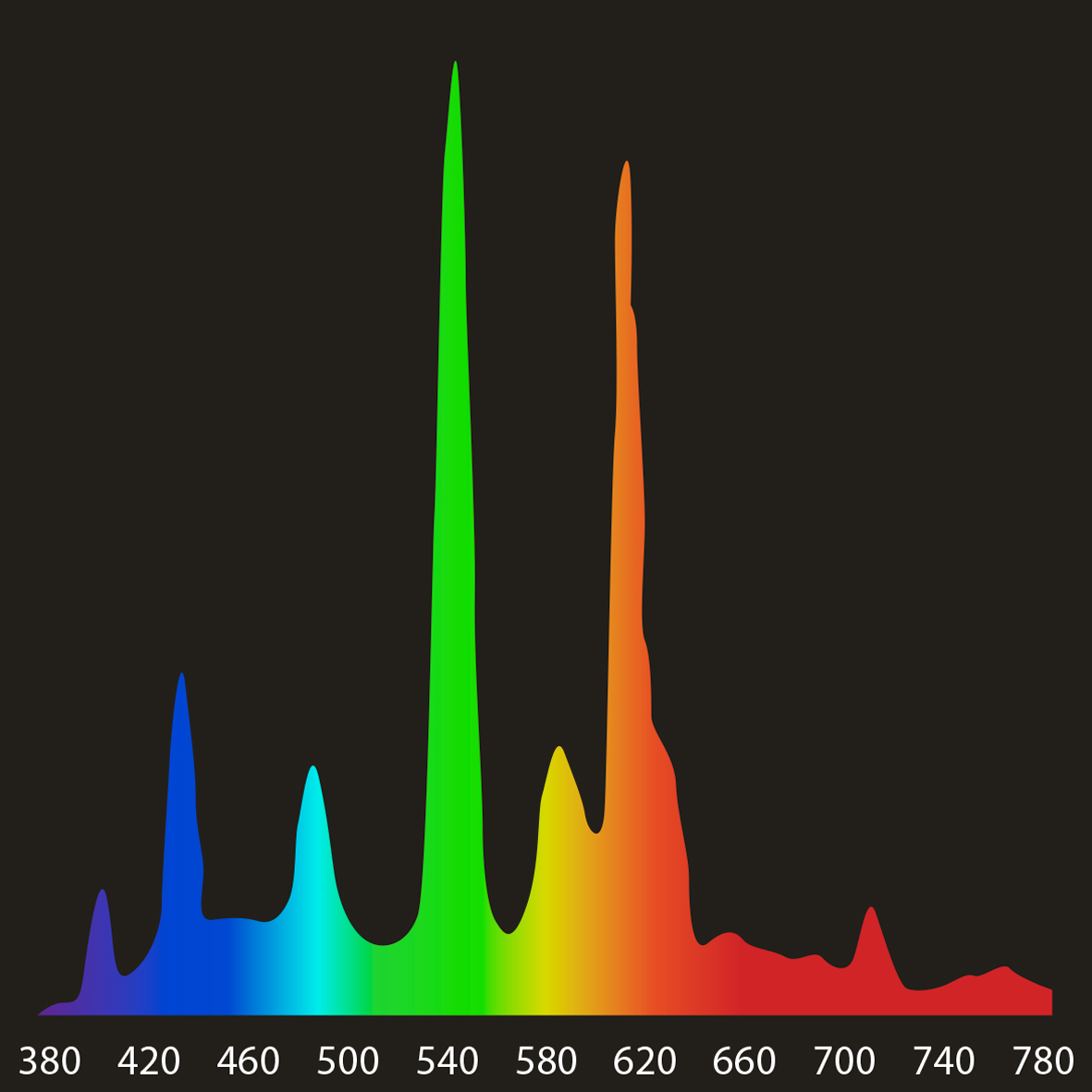
Fluorescent lamp
Fluorescent tube light is the dated technology of the last century and generally has the lowest light quality because its spectrum is discontinuous and the CRI value (colour rendering index or colour fidelity when compared to the Sun, which has a maximum CRI of 100) is generally low. Also, flicker is present which is invisible to the eye but detected by the brain and can cause headaches and other problems. Additionally, the fluorescent lamp emits in the Harmful Blue light violet and neighbouring blue regions and, conversely, does not emit sufficient energy in the red and deeper red photobiomodulation regions.
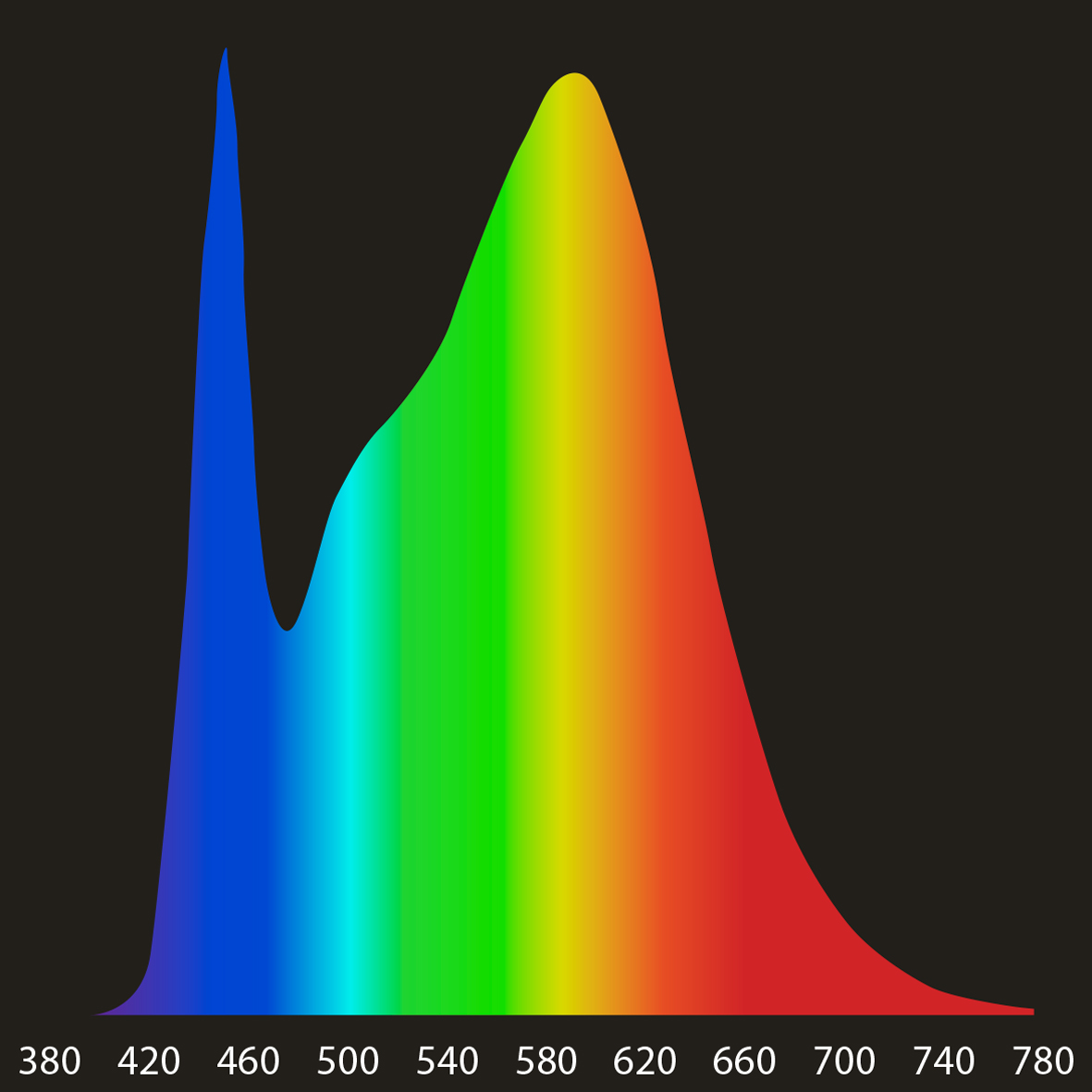
Conventional LED light source
Conventional LEDs have a continuous spectrum except for the prominent drop in the procognitive melanopic region ~480 nm. There is a typical concentrated peak in the blue region of 450 nm. Additionally, flicker and low CRI value are common with no radiation emitted in the photobiomodulating deeper red region of the visible spectrum.
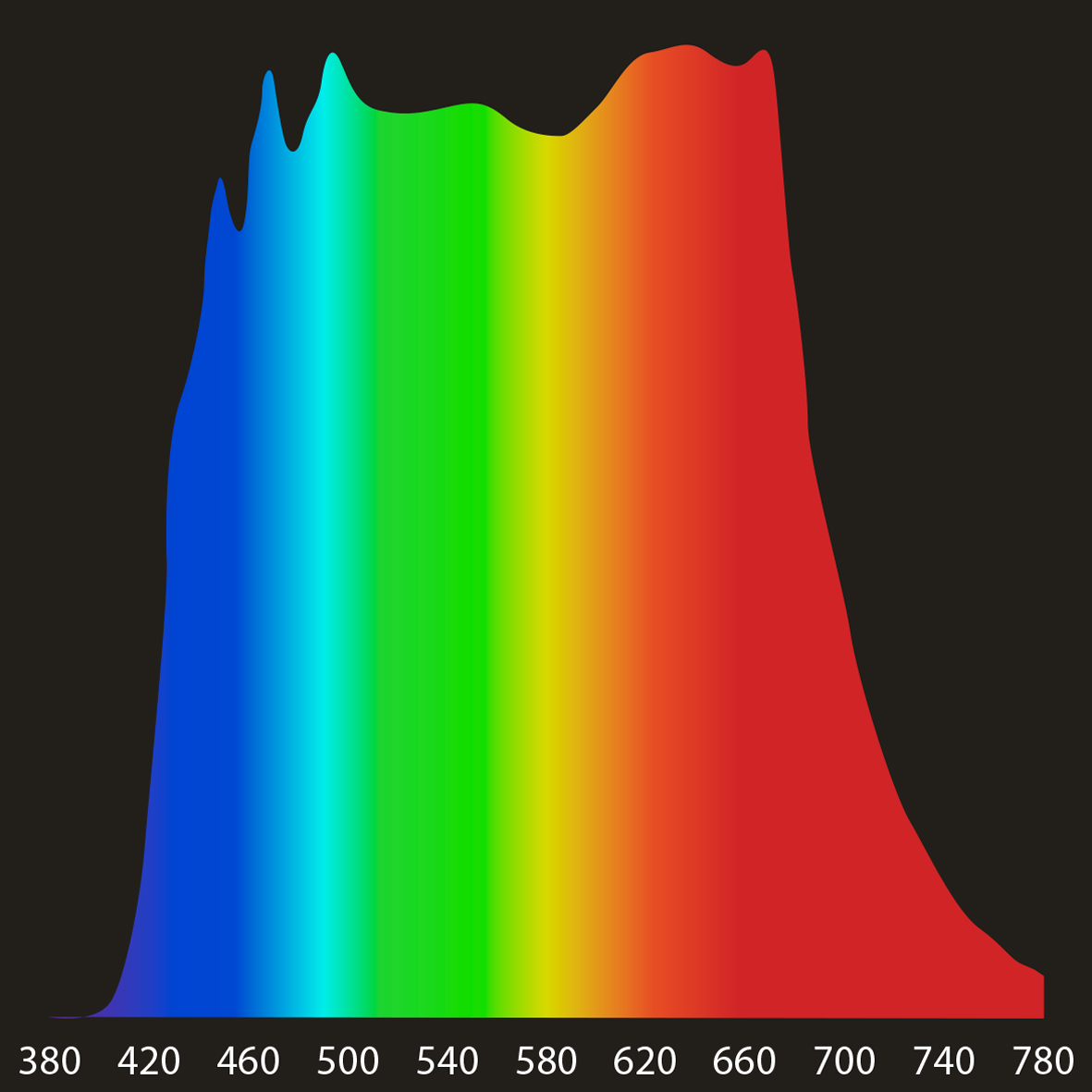
Spectrasol LED light source
The Spectrasol luminaire emits a continuous spectrum across the visible spectrum imitating Sun’s high-quality bright daylight in terms of both the visual and non-visual effects on the eye, but without any UV radiation or concentrated energy in the Harmful Blue light region. Additionally, continuous radiation in the photobiomodulation red region of 670 nm is present.
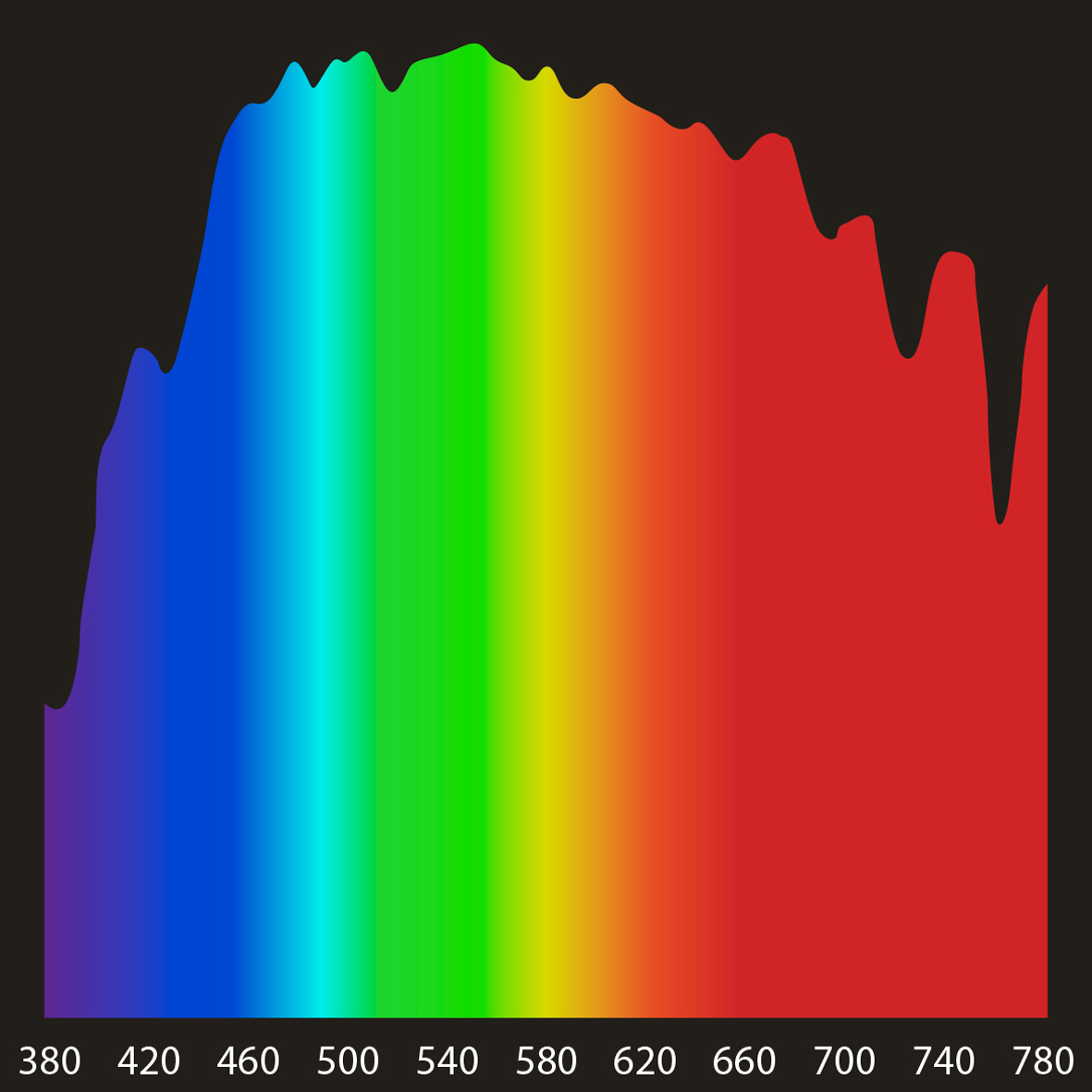
Sun at noon
Daylight at noon constitutes of bright white light with a continuous spectrum spanning across the UV region, the entire visible spectrum as well as the photobiomodulation region (deep red and near infrared spectrum). The emission continues deeper into invisible infrared and radio wavelengths.

